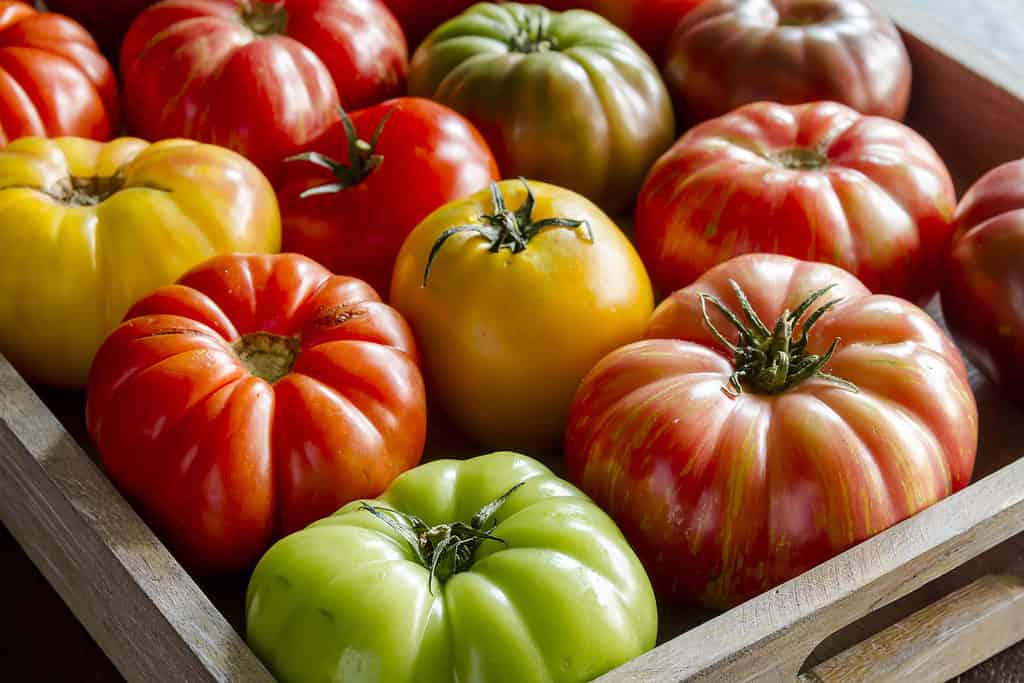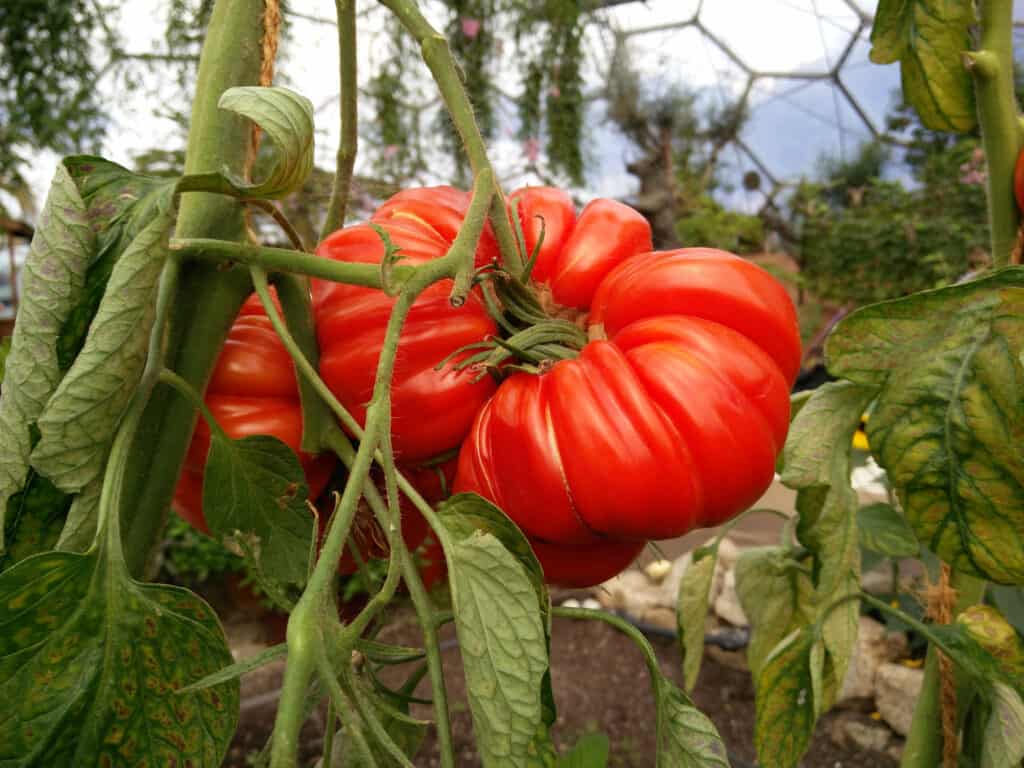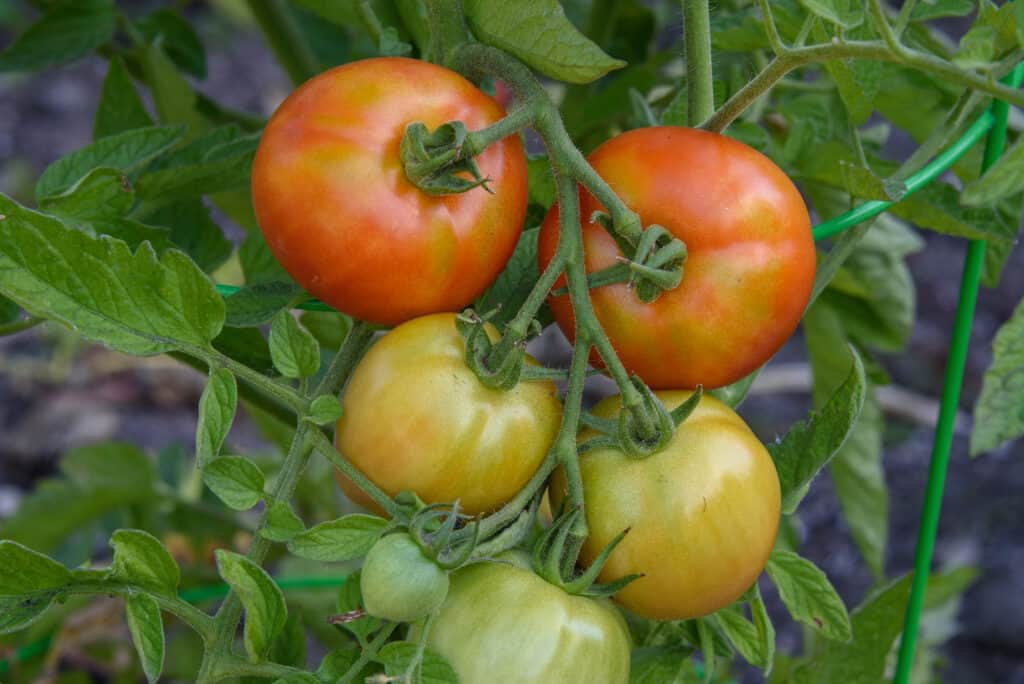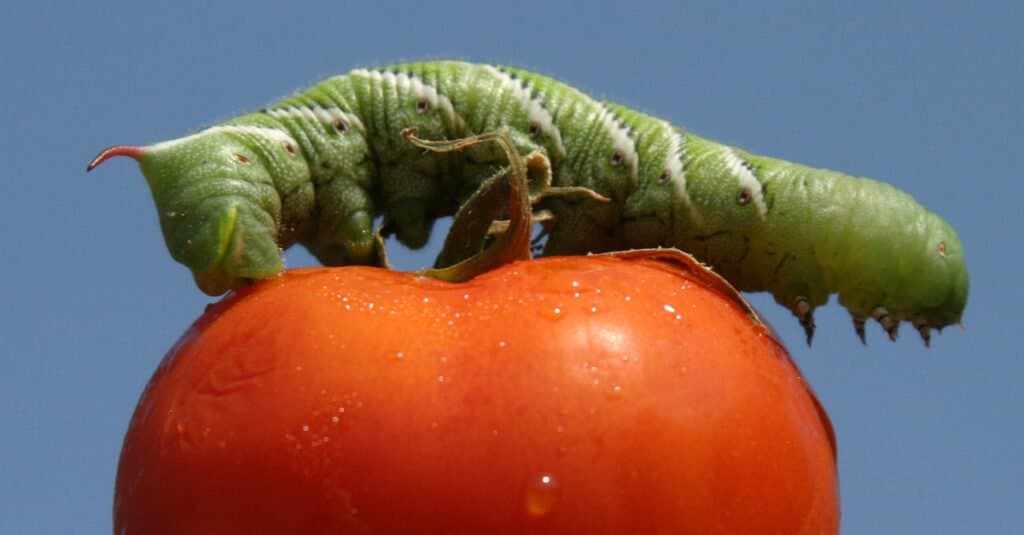As the chilly winds of winter give way to the warm sunshine of spring, many eager gardeners in North Carolina can’t wait to get their hands dirty and start planting their favorite crop. But before you rush out to plant those juicy tomato seedlings, there’s an important gardening tip you need to know: wait until after the last frost! This crucial step can make all the difference in the success of your tomato harvest, and in this article, we’ll explore why. So grab your gardening gloves, as we discuss when to plant tomatoes in North Carolina, and six tips for doing so.

Heirloom tomatoes (pictured) contain vitamins A and C, beta-carotene, calcium, and fiber.
©Teri Virbickis/Shutterstock.com
When to Plant Tomatoes in North Carolina: What is a Tomato?
The tomato (Solanum lycopersicum) is a fruit that is widely used in cooking. It is considered a staple in many cuisines around the world. It is believed to have originated in the Western region of South America, specifically in the Andean highlands of modern-day Peru, Bolivia, and Ecuador.
The wild ancestor of the tomato plant is known as Solanum pimpinellifolium. This wild variety is still found growing in the Andean region of South America. Solanum pimpinellifolium produces small, yellow fruit with a thin skin and a sour taste. It is thought to have been domesticated by indigenous peoples in the region over 2,000 years ago.
The tomato was gradually introduced to other parts of South America. It was introduced in what is now Mexico, where it was first cultivated by the Aztecs. Spanish conquistadors brought the tomato to Europe in the 16th century. The tomato quickly gained popularity as an ornamental plant in gardens, but was not, at least initially, widely used in cooking. It wasn’t until the 18th century that the tomato began to be recognized as a food crop in Europe. It was brought to North America by European colonizers in the early 18th century. Today, the tomato is one of the most widely cultivated and consumed fruits in the world. Many different varieties have been developed for their flavor, size, and hardiness.

This wild tomato plant produces small, yellow fruit with a thin skin and a sour taste, and is thought to have been domesticated by indigenous peoples in the region over 2,000 years ago.
©Anakumka/Shutterstock.com
Tomatoes: A Popular Crop
Tomatoes are one of the most popular garden crops in North Carolina. They are beloved for their juicy, sweet fruit, which adds flavor and nutrition to a wide variety of dishes. However, despite their popularity and hardiness in warmer temperatures, tomatoes are actually tender annuals that are highly susceptible to frost damage. Tomatoes are so sensitive to cold that they will not grow well if exposed to temperatures below 50 degrees Fahrenheit. If a tomato plant is exposed to frost, the cold temperatures can damage the delicate plant tissues, causing the leaves to turn black and the plant to become stunted or die.
This is why it’s important to wait until after the last frost before planting tomatoes in North Carolina. While it may be tempting to get a head start on the growing season, planting too early can result in disappointment and frustration when your tomato plants fail to thrive.
By waiting until the risk of frost has passed, you’ll give your tomato seedlings the best chance to grow. Waiting produces a strong and healthy harvest of ripe, delicious fruit. And with a little bit of patience and care, you’ll be rewarded with a successful tomato crop that will provide a delicious taste of summer all season long.

Tomatoes are one of the most popular garden crops in North Carolina.
©iStock.com/Sophie Shoults
When to Plant Tomatoes in North Carolina: Know Your Zone
North Carolina has a range of USDA Hardiness Zones from 5b to 8b. The state has a diverse climate, with the mountainous regions in the Western part of the state experiencing colder temperatures and the coastal regions in the Eastern part of the state enjoying milder winters. The last frost dates in the majority of North Carolina are April 1 to 15. A small area in Western North Carolina’s last frost dates are April 16 to May 15. A small area in Eastern North Carolina’s last frost dates are March 1 to 31. If you are unsure of your USDA Zone, you can find it here. The USDA Hardiness Zones for North Carolina:
- Zone 5b: -15°F to -10°F
- Zone 6a: -10°F to -5°F
- Zone 6b: -5°F to 0°F
- Zone 7a: 0°F to 5°F
- Zone 7b: 5°F to 10°F
- Zone 8a: 10°F to 15°F
- Zone 8b: 15°F to 20°F
Here is a breakdown of the USDA Hardiness Zones for different regions of North Carolina:
- Western North Carolina, including the Appalachian Mountains, is generally in USDA Hardiness Zones 5b to 7a, with higher elevations in the mountains being in Zone 5a.
- Central North Carolina, including the Piedmont region, is generally in USDA Hardiness Zones 7a to 7b.
- Eastern North Carolina, including the Coastal Plain and Outer Banks, is generally in USDA Hardiness Zones 8a to 8b.
Please keep in mind that these are general ranges and that there can be local variations depending on microclimates, elevation, and other factors.

North Carolina has a diverse climate, with the mountainous regions in the Western part of the state experiencing colder temperatures and the coastal regions in the Eastern part of the state enjoying milder winters.
©knelson20/Shutterstock.com
When to Plant Tomatoes in North Carolina: Stay Informed
Staying informed about the weather regarding the last frost dates in your area is essential for successful tomato gardening. By using a combination of resources such as local weather forecasts, gardening apps, cooperative extension offices, frost date calculators, or gardening journals, you can stay up-to-date on the latest weather patterns and make informed decisions about planting and harvesting your crops. One way to keep informed is by consulting local weather forecasts. Checking the weather forecast on a regular basis is an easy way to stay informed about upcoming weather patterns, including frost warnings.
Using a gardening app is a high-tech way to keep abreast of the weather patterns in your region. There are several gardening apps available that help you keep track of weather patterns and frost dates.
Check with your local cooperative extension office. Cooperative Extension offices are a valuable resource for gardeners, providing information and advice on a wide range of gardening topics. They can also provide information on frost dates in your area and other weather-related topics.
Frost date calculators are another high-tech online tool that can help you determine the average date of the last frost in your area. These calculators typically require you to enter your location information and will provide an estimate of the last frost date based on historical weather data. Once you start gardening, keep a gardening journal. Keeping a gardening journal can help you track weather patterns and the success of your garden over time. By recording information such as planting dates, weather conditions, and harvest dates, you can gain valuable insights into the best times to plant and harvest crops in your area

Keeping a gardening journal can help you track weather patterns and the success of your garden over time.
©marilyn barbone/Shutterstock.com
When to Plant Tomatoes in North Carolina: Tips for Planting
Start by selecting a tomato variety that is well-suited for North Carolina’s climate and growing conditions. Some good choices include Celebrity, Better Boy, Early Girl, and Cherokee Purple.
Purchase or start tomato plants that are healthy and disease-free. Avoid plants that show signs of disease or stress. Plant tomatoes in North Carolina after the danger of frost has passed, typically in early to mid-April. Tomatoes require well-drained soil. If your soil tends to be heavy and clay-like, consider adding compost or other organic matter to improve drainage. Tomatoes need consistent moisture to grow and produce fruit. Water deeply once or twice a week, depending on rainfall and soil conditions.
Tomatoes require regular fertilization to thrive. Use a balanced fertilizer or one that is high in phosphorus to promote fruit development. Keep an eye out for common tomato pests and diseases, such as aphids, hornworms, and blight. Tomatoes are vining plants that require support, such as a stake or cage, to keep the plant upright and prevent damage to the fruit.

Plant tomatoes in North Carolina after the danger of frost has passed, typically in early to mid-April.
©Dr.E.Srinivas/Shutterstock.com
Tomato Pests
There are several pests that can affect tomato plants in North Carolina. To prevent or control these pests, it’s imperative to practice good garden hygiene, such as removing plant debris and weeds and rotating crops to prevent the buildup of pest populations in the soil. You can also use organic controls, such as insecticidal soaps or neem oil, as needed. Here are some of the pests to be lookout for:

The tomato hornworm can quickly strip a tomato plant of its leaves and fruit
©mikeledray/Shutterstock.com
- Tomato hornworm (Manduca quinquemaculata): This large green caterpillar can quickly strip a tomato plant of its leaves and fruit. Look for the telltale horn-like protrusion on its back to identify it.
- Aphids (Uroleucon): These small, soft-bodied insects can quickly reproduce and suck the sap out of a tomato plant, causing stunted growth and yellowing leaves.
- Whiteflies (Aleyrodidae): These tiny white insects can infest tomato plants and cause yellowing leaves and a sticky residue on the leaves.
- Spider mites (Tetranychidae): These tiny pests can cause yellowing and stippling of tomato leaves, and can also cause the leaves to become covered in fine webbing.
- Stink bugs (Pentatomidae): These insects can damage tomato fruit by piercing it and causing it to become misshapen or rot.
- Cutworms (Noctuoidea): These caterpillars feed on the stems of young tomato plants, causing them to wilt and die.
- Tomato fruit worms (Helicoverpa zea): These caterpillars can bore into tomato fruit, causing it to become misshapen or rot.
Thank you for reading! Have some feedback for us? Contact the AZ Animals editorial team.








